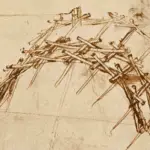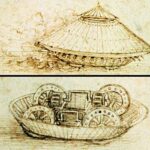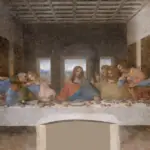Leonardo da Vinci Vitruvian Man
The Vitruvian Man drawing is one of Leonardo da Vinci‘s most iconic works. It represents the perfect blend of art and science.
This masterpiece showcases the ideal human proportions, as inspired by the writings of the ancient Roman architect Vitruvius.
It stands as a symbol of the Renaissance‘s dedication to exploring humanity’s connection with the universe.
Exploring this drawing offers insights into Leonardo‘s harmonious vision of geometry, anatomy, and symmetry.
You can marvel at how the male figure fits perfectly within a circle and a square, representing the harmony between humans and nature. Leonardo’s work continues to fascinate people with its blend of meticulous observation and philosophical inquiry.
Those seeking to understand the drawing’s significance must know how Vitruvius’ ideas on architecture and the human body influenced Leonardo’s exploration of these themes.
The Vitruvian Man is a fundamental study of the balance between art and anatomical science. It captures the essence of the Renaissance quest for knowledge and understanding.
Vitruvian Man Drawing: Historical Context
Leonardo da Vinci’s drawing of the Vitruvian Man is a remarkable blend of art and science. It captures human proportions with mathematical precision and artistic mastery.
Two key influences shaped this iconic artwork: da Vinci’s Renaissance environment and the teachings of the ancient Roman architect Vitruvius.
Leonardo da Vinci’s Era
Europe experienced a revival of art, science, and culture during the Renaissance. Leonardo da Vinci epitomized this era’s spirit of discovery.
He combined artistic skill with scientific inquiry, as seen in the Vitruvian Man drawing.
This period encouraged a deep interest in human anatomy, which led Da Vinci to explore the human form in unmatched detail.
Influential thinkers and artists of his time shared knowledge, fostering interdisciplinary studies.
This cultural environment significantly impacted da Vinci’s approach to his work, which combined the visual arts with empirical study.
His innovative methods provided a new way to view art and its connection to science.
Influence of Vitruvius
An ancient Roman architect, Vitruvius outlined principles of architecture and proportion that inspired da Vinci. His writings emphasized harmony between human dimensions and architecture.
Da Vinci applied these concepts to human anatomy in his drawing, illustrating the ideal human body proportions.
This influence is evident in the geometric forms of the Vitruvian Man drawing, where the human figure aligns with a circle and a square.
This representation showcases Vitruvius’ belief in symmetry and brings a philosophical dimension to da Vinci’s creation.
The combination of Vitruvius’ ideas with Leonardo’s artistry highlights the drawing’s significance as a fusion of art and science.
Analysis of the Artwork
The Vitruvian Man by Leonardo da Vinci is a remarkable representation of the blend between art and science. This illustration uses geometric forms to link the human body with the universe, revealing deep insights into the Renaissance’s ideals.
Iconography
The iconography of the Vitruvian Man showcases da Vinci’s engagement with proportion and symmetry.
This drawing perfectly fuses ancient Roman architect Vitruvius’s principles with Renaissance ideals.
It features a male figure in two superimposed positions with arms and legs apart, inscribed in a circle and a square.
This Vitruvian Man artwork becomes a potent symbol for harmony in mathematics and the universe, capturing the humanist belief that humans mirror the larger cosmos.
Composition
Leonardo’s skillful composition illustrates the unity of art and science.
He achieves balance and harmony within the drawing by using precise geometric shapes.
The two positions of the figure inside the circle and square create a dynamic visual design.
The meticulous placement of the limbs demonstrates da Vinci’s attention to detail and indicates his understanding of human anatomy and mathematical precision.
This piece’s composition makes it an enduring example of the intersection of science and art during the Renaissance era.
Proportions
The proportions in the Vitruvian Man drawing reflect da Vinci’s exploration of the human form‘s mathematical dimensions.
The figure’s outstretched limbs fit perfectly within the circle and square, representing ideal human proportions.
These measurements align with Vitruvian theories and embody the Renaissance pursuit of balance and beauty.
According to Britannica, the drawing underscores the notion that the body and these shapes have a precise geometric correspondence, symbolizing physical and cosmic harmony.
Scientific Significance
The Vitruvian Man by Leonardo da Vinci is more than an artwork; it represents the blend of art and science.
It reflects Leonardo da Vinci’s mastery of anatomy and his fascination with geometry and proportion.
Anatomical Accuracy
Da Vinci’s Vitruvian Man drawing showcases remarkable anatomical accuracy.
At a time when the human body was often misunderstood, this drawing highlighted a detailed understanding of human anatomy.
Leonardo studied cadavers, gaining insights into muscles, bones, and skin.
The Vitruvian review demonstrates this scientific exploration, showing how the parts of the body fit together harmoniously.
His ability to combine art with detailed anatomical study set a new standard for realistic human representation, influencing artists beyond the Renaissance.
Geometry and Symmetry
Geometry plays a crucial role in the Vitruvian Man artwork.
Da Vinci aligned the figure within a square and a circle, representing geometric symmetry, central to Renaissance art.
Vitruvian Man geometry illustrates the connection between human proportions and architectural principles.
This combination highlights the belief that humans reflect the structure of the universe.
It emphasizes symmetry as an ideal in art and architecture.
By doing so, Leonardo illustrates the beauty and mathematical logic inherent in nature and design.
The Golden Ratio
The concept of the Golden Ratio is evident in the Vitruvian Man’s proportions.
This mathematical principle suggests a harmonically pleasing ratio found in nature.
Leonardo’s portrayal aligns with the Golden Ratio, linking the human body to universal design principles.
The Vitruvian Man proportions display how different body parts relate to each other numerically.
This drawing serves as a visual definition of mathematical beauty, merging art, mathematics, and nature.
Through this, Leonardo demonstrated how art and science are not separate but deeply interconnected disciplines.
Cultural Impact
Leonardo da Vinci’s drawing of the Vitruvian Man has left a lasting mark on Renaissance and modern cultures. This iconic artwork symbolizes the blend of art and science and has inspired various interpretations over the centuries.
Renaissance Influence
During the Renaissance, the Vitruvian Man artwork embodied the era’s fascination with human anatomy and proportions.
Artists and scholars admired how Da Vinci combined scientific accuracy with artistic expression.
The drawing’s golden ratio and geometric patterns mirrored the Renaissance pursuit of perfection.
Many artists of the time were motivated by this work to explore similar themes.
Leonardo aimed to capture the harmony between the human body and the universe by depicting a man with perfect proportions.
Thus, the drawing symbolized the Renaissance’s focus on the ideal human.
Contemporary Interpretations
In modern times, the Vitruvian Man’s meaning has evolved beyond its initial artistic and scientific context.
Today, it represents ideas of balance and symmetry in various fields, such as architecture and design.
Artists and creators continue to reinterpret this drawing, seeing it as a model of human potential and exploration.
In popular culture, the Vitruvian Man image is often used to illustrate the intersection of art, science, and philosophy.
Its iconic nature makes the drawing a recognizable reference in modern media, highlighting its timeless significance and enduring relevance.
Preservation and Conservation
The Vitruvian Man drawing requires careful handling to ensure its longevity. Because of its delicate nature, experts keep it in a controlled environment.
Controlled levels of light and temperature help prevent damage to its fragile ink and paper.
To protect this iconic piece of Vitruvian man-art, it is rarely displayed in public. When shown, it is generally under strict supervision, using protective barriers to minimize exposure. Preventing any direct contact is crucial for most cultural institutions.
Storage Guidelines:
- Temperature: 18-22°C
- Humidity: 40-50%
- Lighting: Low UV-emitting sources
These measures are vital for maintaining the quality and lifespan of the Vitruvian Man by Leonardo da Vinci. The balance between public display and conservation is always a challenge for curators.
Reproductions and digital formats allow people to appreciate the Vitruvian man image without risking the original. This approach supports education and preservation, ensuring the drawing remains part of cultural discussions about Vitruvian man proportions.
Institutions focus on educational efforts to explain what the Vitruvian man means and its importance in art and science. Public access doesn’t need to come at the cost of the drawing’s integrity, ensuring future generations can learn from this masterful work.
Exhibition History
Leonardo da Vinci’s Vitruvian Man drawing is a masterpiece often cited for depicting ideal human proportions. Though the artwork is renowned, its exhibition history has been selective due to its delicate nature.
Notable Displays
One of the most significant exhibitions of the Vitruvian Man was held at the Louvre in 2019, marking the 500th anniversary of Leonardo da Vinci’s death.
Although typically kept out of public view due to its fragile condition, the Gallerie dell’Accademia in Venice lent the drawing. Before this, the Vitruvian Man had been infrequently displayed, underscoring its status as a rare but treasured piece in art history. Each exhibition offers a unique opportunity for art enthusiasts to appreciate the intricacies of da Vinci’s work.
Public Accessibility
The Vitruvian Man is generally kept out of public view to ensure its preservation. It is part of the collection at the Gallerie dell’Accademia in Venice, where careful measures are taken to protect it.
Because of its condition, the artwork is not included in regular exhibitions. Art lovers and scholars often rely on reproductions and analyses to study its proportions and meanings.
On rare display, it attracts significant public attention, demonstrating its enduring fascination and importance in understanding Renaissance art and human anatomy.
Legal and Ethical Considerations
The Vitruvian Man drawing, a famous piece by Leonardo da Vinci, has sparked numerous legal and ethical debates ranging from ownership claims to discussions about commercial rights.
Ownership Disputes
Ownership disputes over the Vitruvian Man drawing often center on national heritage laws. Italy has strict regulations aimed at preserving cultural heritage. It considers such art national treasures, making it difficult for private entities to assert ownership claims.
These laws have led to debates on whether artworks in public collections can enter the market. The Vitruvian Man is housed in the Galleria dell’Accademia di Venezia, under Italy’s robust cultural protection. This protection elevates the artwork’s status, complicating ownership-related legal battles.
Image Rights
The question of who controls the image rights of the Vitruvian Man artwork presents another legal challenge. Although Leonardo da Vinci died in 1519, making the image public domain under European laws, Italy implemented additional restrictions.
For example, using the Vitruvian Man image for commercial purposes requires permissions and possibly fees.
Laws like these reflect a broader trend of governments influencing historical art. This regulation impacts everything from educational uses to commercial marketing.
Enforcement of these laws ensures revenue generation for public institutions and preserves the drawing’s integrity. Legal professionals and artists must stay informed about these evolving rights to effectively navigate the use of such iconic images.
Technical Studies
Leonardo da Vinci’s Vitruvian Man drawing showcases impressive technical skills. Understanding the materials and how the artwork has been preserved is essential to appreciating its lasting significance.
Materials and Techniques
Leonardo da Vinci created the Vitruvian Man drawing in the late 15th century using a metal point, pen and ink, and watercolor on paper.
The different media allowed for precise lines and detailed shading, highlighting his mastery of art and science.
He aimed to accurately capture human proportions, inspired by the ideas of the ancient Roman architect Vitruvius.
Creating such detailed work required a deep understanding of anatomy.
Leonardo’s detailed study of the human body involved dissecting numerous corpses, which provided him with the knowledge to illustrate the perfect proportions from Vitruvius.
This dedication to precision and scientific inquiry makes this art piece remarkable in Renaissance art.
Condition Over Time
Over the centuries, the Vitruvian Man has faced challenges in preservation. Due to its age, the paper’s condition is delicate, and exposure to light can lead to further deterioration.
Institutions must carefully manage their exposure to prevent damage.
While innovative, the skilled use of metalpoint and watercolor contributes to the drawing’s fragility.
Art historians and conservationists take extraordinary measures to ensure its long-term preservation.
For instance, the drawing is usually kept in controlled environments to minimize exposure and maintain its condition.
The Vitruvian Man’s status as a vital piece of art history requires ongoing efforts to preserve its integrity. This will allow future generations to explore its mathematical and artistic significance, as da Vinci understood.
Influence on Modern Art
The Vitruvian Man, a famed drawing by Leonardo da Vinci, significantly impacted modern art by highlighting the connection between art and science. This drawing has shaped artistic techniques and is used in education to explore proportion and human anatomy.
Artistic Inspirations
The influence of the Vitruvian Man in modern art springs from its unique representation of human proportions.
Artists have embraced this iconic image to explore symmetry and balance.
Da Vinci’s understanding of geometry and proportion inspired countless artists to integrate these concepts into their creations, resulting in more scientifically informed designs.
Modern artists often reference the Vitruvian Man to explore themes of human perfection and the relationship between humans and the universe.
This drawing is a cornerstone for understanding proportion, seen in various art forms and installations today.
Educational Use
The Vitruvian Man is vital for learning about human anatomy and proportion in educational settings.
The drawing illustrates ideal human-body ratios, which have become helpful for both art students and those studying human biology.
Educational resources often incorporate the Vitruvian Man drawing to teach these principles straightforwardly.
Art classes analyze the drawing to understand its precision, while anatomy lessons use it to juxtapose scientific data with artistic interpretation.
This dual role strengthens its importance in forming the groundwork for much of what is taught about human proportions today.
Comparative Analysis
The Vitruvian Man by Leonardo da Vinci is not just a drawing; it holds significant meaning in the history of art and human anatomy. This analysis explores how this piece relates to other works by da Vinci and contrasts with art from the same period.
Similar Works by da Vinci
Leonardo da Vinci often explored human anatomy in his art. The Vitruvian Man drawing is a prime example, showing detailed human body proportions.
This approach is evident in his anatomical sketches, such as studies of the human skull and muscles.
In his notebooks, da Vinci combined scientific inquiry with artistry.
He used sketches to illustrate the balance between art and mathematics, echoing themes in the Vitruvian man’s artwork. These notebooks reveal da Vinci’s deep interest in the golden ratio, which he applied to his understanding of human proportions.
His painting, The Last Supper, also uses proportion and perspective. Both works demonstrate how da Vinci merged art with science.
The Vitruvian Man not only fits into this category but serves as a guide on how proportions can define beauty and function.
Contrasts with Contemporary Art
Many artists during da Vinci’s time focused on religious themes and symbolic imagery. The Vitruvian Man diverges from this by emphasizing mathematical precision and human anatomy.
While most contemporary art highlighted divine subjects, this piece explored the earthly form of man.
Art from the Renaissance often depicted religious scenes, but da Vinci’s work took a different approach. The Vitruvian man’s meaning reflects a shift towards humanism and the study of the natural world.
Artists like Michelangelo also studied anatomy, but da Vinci’s work went beyond what was typical at the time.
In contrast, other contemporary artists focused on spiritual or mythical themes. Da Vinci, however, used his observations to understand the human figure through geometry. This combination of science and art set his work apart, establishing a standard for future generations.
Final Thoughts
The Vitruvian Man drawing remarkably represents the harmony between art and science. Leonardo da Vinci skillfully blends anatomical precision with principles of geometry, reflecting his interest in human proportion and symmetry.
This drawing is an artistic endeavor and a study of the human body. It shows the influence of Vitruvius, a Roman architect who believed in the correlation between human form and architectural proportion.
Key Elements:
- Proportion: Balancing circles and squares to depict the human figure.
- Symmetry: Highlighting harmony in form and function.
- Influence: Inspiration drawn from Vitruvius’ writings.
The Vitruvian Man is a masterpiece of the Renaissance and a visual tool that bridges various fields, including art, science, and philosophy. Over the years, many scholars have praised its significance.
You can explore the link between da Vinci’s innovative ideas and his practical inventions in detail at the Leonardo da Vinci Inventions. This connection shows his multifaceted genius, which extends beyond the Vitruvian Man drawing.
Frequently Asked Questions
The Vitruvian Man drawing is an iconic representation of human proportion and the study of geometry. It connects art and science by exploring the human body’s symmetry.
What does the Vitruvian Man symbolize?
The Vitruvian Man symbolizes the harmony between human proportions and the universe. Leonardo da Vinci illustrated how the human body reflects the symmetry of the cosmos.
What is the hidden message in Vitruvian Man?
The hidden message explores the connection between physical realms and divine order. Da Vinci used the drawing to demonstrate the unity of art and science.
What does Vitruvian stand for?
Vitruvian refers to Vitruvius, a Roman author and architect whose principles on ideal human proportions inspired da Vinci’s work.
Is the Vitruvian Man theory true?
The Vitruvian Man is based on geometric theories rather than empirical evidence. It is a conceptual illustration of ideal proportions rather than a scientific fact.
What is the math behind the Vitruvian Man?
The drawing embodies mathematical precision. It uses the ratios found in ancient texts to depict ideal human proportions, combining a circle and a square.
What do the words on the Vitruvian Man say?
The text accompanying the drawing refers to Vitruvius’s ideas on ideal body measurements. Da Vinci’s notes provide insights into these ancient guidelines.
What was the original concept of Vitruvian Man?
Vitruvian Man was conceived to illustrate Vitruvius’s principles. It visualized how human anatomy mirrors the universe’s structural design.
What does the Vitruvian Man tattoo mean for guys?
A Vitruvian Man tattoo often signifies the wearer’s appreciation for the balance between art and science. It represents a pursuit of knowledge and understanding.
What is the meaning of the Vitruvian Woman?
While “Vitruvian Woman” is not a historical artifact, it draws from the same principles of proportion. It is a modern adaptation symbolizing equality in representation.
Why does the Vitruvian Man have 4 arms?
The four arms and legs show different positions of the man’s movement. This illustrates the combination of human proportions fitting within a circle and a square.
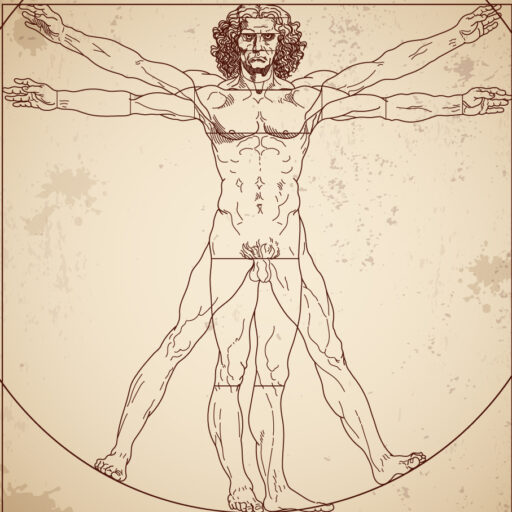
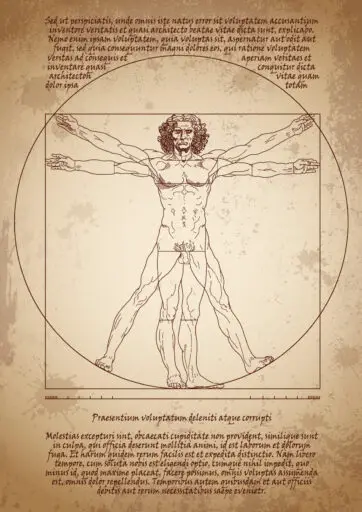
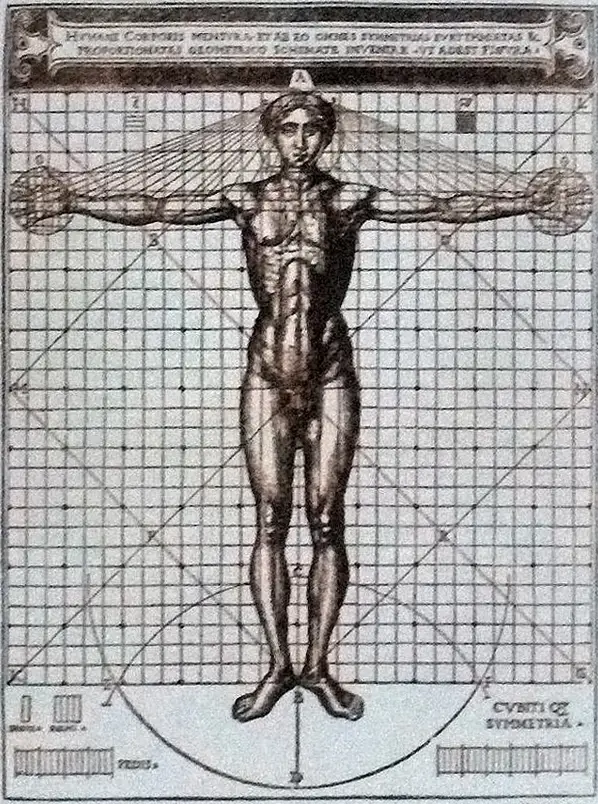
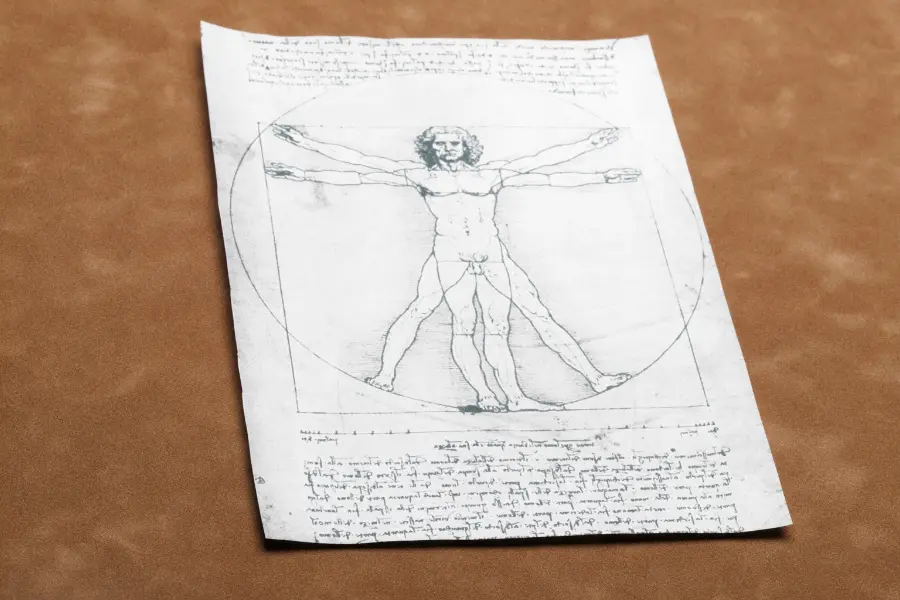
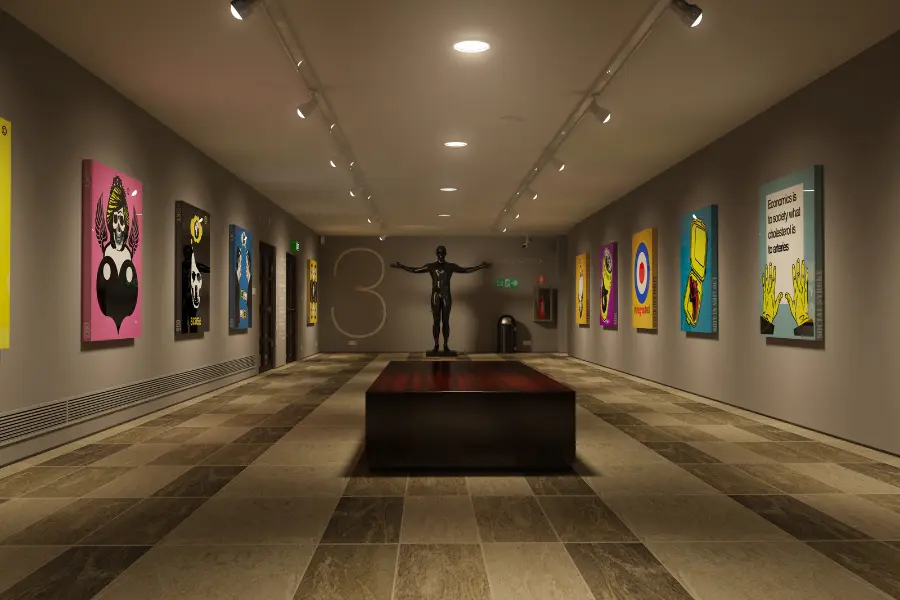
 I’m Leonardo Bianchi, the mind behind Leonardo da Vinci's Inventions. Thanks for visiting.
I’m Leonardo Bianchi, the mind behind Leonardo da Vinci's Inventions. Thanks for visiting. 